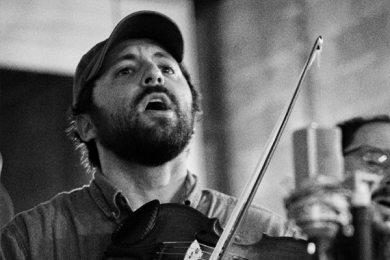Possibly Inaccurate Predictions for the Future
News
Last Week on News and Notes…
Last week was a wrap-up of 2013. Like any end of year review, it was a cheap way of generating content without actually writing much new. So now, it's time for me to pretend to stick out my neck by making vague predictions on where theater will be going in the coming year. Don't worry: there's nothing so specific that you could actually hold me to it at the end of the 2014.
(1) Arts Journalism
It's the end of the year, so it's time for the end of the year lists. The Star Tribune, City Pages, Lavender Magazine and the Pioneer Press are all ready to tell you what the top ten things were in Twin Cities theater this year. (Dominic Papatola released my favorite one so far: a passive-aggressive list that praises some people while telling them that their shows suck.)
There is another top ten list that theatre folks have been circulating, from Cherry and Spoon. It's not a newspaper or a magazine. The writer doesn't get paid. But, on the internet, Cherry and Spoon's reviews sit comfortably next to all the professionals above.
There is always talk about how these are the dying days of journalism, especially for arts journalism. Mainstream newspapers have been cutting staff for years, especially arts journalists. That is a void that will be filled, either by citizen journalists like Cherry and Spoon, or, as Chris Jones reports in the Chicago Tribune, by large arts organizations that want to mask promotional material as journalism.
In the future, look for more non-professional arts journalists to gain traction. The Twin Cities Daily Planet is already pumping out a ton of content, and sites like Minnesota Playlist (which you happen to be reading) and MN Artists offer plenty of opportunities for hopeful writers. Keep an eye out for more Cherry and Spoon contemporaries, independent bloggers like the good folks at Arts Junkie and Aisle Say.
(2) Funding
It's a tough time for granting. The budget fights in Washington took a bite out of the NEA, and appropriations for that organization have fallen steadily in the past four years. The NEA's budget will probably be cut again in the coming years, despite dire predictions as to the consequences. More budget fights are inevitable, and the arts are convenient targets for budgetary bullying. In Minnesota, conservatives scored a minor victory in in restricting artist travel grants and will most likely pursue more as opportunities arise.
In the meantime, foundational support has started to grow again, but not enough to outpace inflation; and, as I have discussed in the past, the majority of the roughly $3.5 billion in foundational support to the arts is given to large legacy organizations. There is a similar trend for private donations. Robert Reich at the Christian Science Monitor argues that patterns like this are just creating what he calls "cultural palaces" for the wealthy.
For the rest of us, there will be growing competition for arts grants, both governmental and foundational. In the coming years, funders will be looking for projects to do more than just present a piece of art. Where "community" has been the big buzzword in grant applications for several years, look for "Creative Placemaking" to take its place.
Since an influential white paper made the rounds in 2010, government programs like the NEA, private institutions like the Kresge Foundation and public/private partnerships like ArtPlace have all jumped on the Creative Placemaking bandwagon, and you'd better do your research on what that means, because it's the big idea that will probably come to dominate granting in the next few years.
In the meantime, crowdfunding is becoming the fundraising of choice for new companies. As it happens, Kickstarter raises more money for artists than the NEA, and dance projects are the most likely Kickstarter projects to get fully funded. For the past two years, this strategy has helped fund the Indiegogo and RocketHub.
(3) Spaces
Minnesota is filled to the brim with small, itinerant theater companies (Chicago calls this "storefront theatre", but here in the Twin Cities we don't need fancy terms like that). Currently, we are on the upswing in the constant churn of new companies, but there are precious few places to hold all those companies. With the closure of an affordable space like Gremlin Theatre, the rest of the small spaces are filling up fast.
This is leading to companies and individual performers finding creative solutions to the lack of traditional space. We are already familiar with projects like Off-Leash Area's performance space in their garage and Open Eye's driveway tour; but have you seen one of the growing number of living room performances put on by local artists?
Of course, companies like Skewed Visions have been producing site-specific work in the Twin Cities for years, but there is an upswing in the number of local companies jumping out of traditional theatre spaces. This year, you could have seen plays in a machine shop, a university's lecture hall, a huge abandoned retail space, and a big chunk of Lowertown St. Paul.
With the Fringe Festival once again embracing site specific plays, you can bet this out-of-the-box thinking is going to start infecting more and more of the theater community.
(4) Choices
Give all this--the changing of arts journalism, funding and space--what programming choices will theaters be making in the future?
For the big guys, those choices will probably be pretty conservative. On Broadway, the top-grossing shows of the year were mostly old classics and revivals. In 2014, look for more revivals, jukebox musicals and adaptations of movies. Barring the occasional Kinky Boots and Book of Mormon, the upscale professional world looks to continue its trend of playing it safe.
Here at home, the Guthrie ended up in deficit in a year in which it thought it was taking risks on new work. There is certainly a lot of room for debate over what the big G considers "risky" and "new work", but I suspect they will be cutting back on a few things in the years to come, including world and regional premieres. The other larger organizations in town who are sitting on smaller but more stable financial footing, like Park Square and the Jungle, will continue down the middle path, offering a few more regional premieres than in the past, but ultimately anchoring seasons around classics.
For the rest of us, all bets are off. With so much competition on the small scale and so little space and money to go around, I expect there to be a lot of experimentation going on. As I've said before, Some Reading for the New Year
What else is there to say about the future of theater? How about an old article from Harvard Magazine? Sometimes, the retro-future is the best future.




